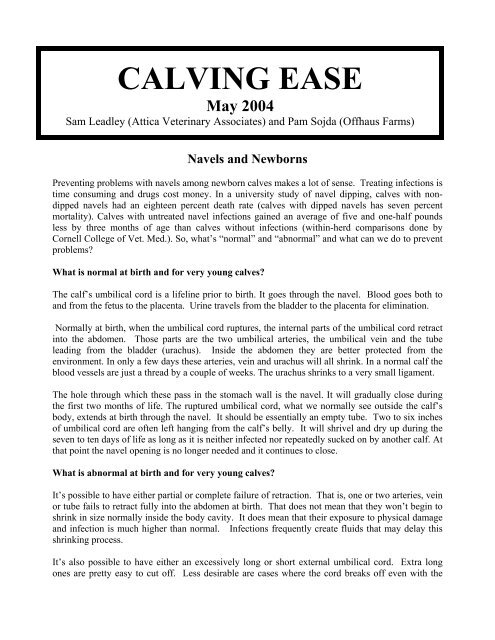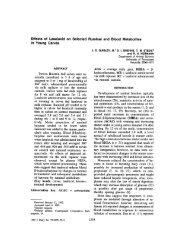Navels and Newborns (Calving Ease) - Calf Notes.com
Navels and Newborns (Calving Ease) - Calf Notes.com
Navels and Newborns (Calving Ease) - Calf Notes.com
Create successful ePaper yourself
Turn your PDF publications into a flip-book with our unique Google optimized e-Paper software.
CALVING EASE<br />
May 2004<br />
Sam Leadley (Attica Veterinary Associates) <strong>and</strong> Pam Sojda (Offhaus Farms)<br />
<strong>Navels</strong> <strong>and</strong> <strong>Newborns</strong><br />
Preventing problems with navels among newborn calves makes a lot of sense. Treating infections is<br />
time consuming <strong>and</strong> drugs cost money. In a university study of navel dipping, calves with nondipped<br />
navels had an eighteen percent death rate (calves with dipped navels has seven percent<br />
mortality). Calves with untreated navel infections gained an average of five <strong>and</strong> one-half pounds<br />
less by three months of age than calves without infections (within-herd <strong>com</strong>parisons done by<br />
Cornell College of Vet. Med.). So, what’s “normal” <strong>and</strong> “abnormal” <strong>and</strong> what can we do to prevent<br />
problems?<br />
What is normal at birth <strong>and</strong> for very young calves?<br />
The calf’s umbilical cord is a lifeline prior to birth. It goes through the navel. Blood goes both to<br />
<strong>and</strong> from the fetus to the placenta. Urine travels from the bladder to the placenta for elimination.<br />
Normally at birth, when the umbilical cord ruptures, the internal parts of the umbilical cord retract<br />
into the abdomen. Those parts are the two umbilical arteries, the umbilical vein <strong>and</strong> the tube<br />
leading from the bladder (urachus). Inside the abdomen they are better protected from the<br />
environment. In only a few days these arteries, vein <strong>and</strong> urachus will all shrink. In a normal calf the<br />
blood vessels are just a thread by a couple of weeks. The urachus shrinks to a very small ligament.<br />
The hole through which these pass in the stomach wall is the navel. It will gradually close during<br />
the first two months of life. The ruptured umbilical cord, what we normally see outside the calf’s<br />
body, extends at birth through the navel. It should be essentially an empty tube. Two to six inches<br />
of umbilical cord are often left hanging from the calf’s belly. It will shrivel <strong>and</strong> dry up during the<br />
seven to ten days of life as long as it is neither infected nor repeatedly sucked on by another calf. At<br />
that point the navel opening is no longer needed <strong>and</strong> it continues to close.<br />
What is abnormal at birth <strong>and</strong> for very young calves?<br />
It’s possible to have either partial or <strong>com</strong>plete failure of retraction. That is, one or two arteries, vein<br />
or tube fails to retract fully into the abdomen at birth. That does not mean that they won’t begin to<br />
shrink in size normally inside the body cavity. It does mean that their exposure to physical damage<br />
<strong>and</strong> infection is much higher than normal. Infections frequently create fluids that may delay this<br />
shrinking process.<br />
It’s also possible to have either an excessively long or short external umbilical cord. Extra long<br />
ones are pretty easy to cut off. Less desirable are cases where the cord breaks off even with the
<strong>Calving</strong> <strong>Ease</strong> May 2004: <strong>Navels</strong> <strong>and</strong> <strong>Newborns</strong> 2<br />
calf’s belly at the navel. With no external cord at all, the calf has a higher than normal exposure to<br />
pathogens.<br />
In a few cases the tube from the bladder (urachus) may not close off entirely. Thus, urine will drip<br />
for several days from the umbilical cord keeping it damp <strong>and</strong> open to infection.<br />
The opening in the abdominal wall, navel, may not close <strong>com</strong>pletely. We call this opening a navel<br />
hernia. The tendency for closure failure may be partially traced to the calf’s parents. In addition,<br />
infections of the navel area are often associated with failure to properly close the opening.<br />
Prevent infections<br />
Clean calving areas help lower pathogen exposure through the navel <strong>and</strong> umbilical cord.<br />
Prompt treatment of the navel area <strong>and</strong> umbilical cord with 7 percent tincture of iodine solution<br />
(often called navel dip) is an important step in prevention of infections. When used properly, the<br />
solution is applied liberally to both the umbilical cord (part that hangs down) <strong>and</strong> the navel area<br />
(opening in stomach wall where the cord <strong>com</strong>es out of the body). Navel dip solution is an alcohol<br />
solution <strong>and</strong> smells that way. It contains a lot of iodine <strong>and</strong> stains everything brown. In an<br />
emergency, rubbing alcohol may be used until regular navel dip can be purchased. Never substitute<br />
teat dip for navel dip. Teat dip contains a very low concentration of iodine. And, rather than drying<br />
up the umbilical cord, teat dip contains substances that prevent the desired drying.<br />
This dipping process prevents infections three ways. First, it washes away dirt <strong>and</strong> pathogens.<br />
Second, the strong iodine alcohol solution kills germs on contact. Third, the alcohol base of the dip<br />
helps dry up the umbilical cord preventing pathogens from going up the cord into the calf’s body.<br />
Diagnose <strong>and</strong> treat infection promptly<br />
During a study involving 18 farms, college staff examined 410 heifer calves weekly. They felt of<br />
each navel area once a week for eight weeks in a row. They were looking for painful navels <strong>and</strong>/or<br />
thickening of the abdominal wall. Thus, they found that 57 calves had navel infections (fourteen<br />
percent). In the study it was the owners’ responsibility to diagnose <strong>and</strong> treat sick calves. Of these<br />
57 calves with navel infections, owners diagnosed <strong>and</strong> treated only 7. That’s correct. Eighty-eight<br />
percent of the navel infections were neither diagnosed nor treated by the owners!<br />
Our challenge, therefore, is to feel of these calves’ navels before abscesses form. Diagnose<br />
infections consistently <strong>and</strong> early. Treat using the full dose <strong>and</strong> duration of the veterinarian<br />
re<strong>com</strong>mended drug.<br />
If you know of someone that doesn’t currently receive <strong>Calving</strong> <strong>Ease</strong> but would like to, tell them to WRITE to <strong>Calving</strong> <strong>Ease</strong>, 11047<br />
River Road, Pavilion, NY 14525 or to CALL either 585-591-2660 (Attica Vet Assoc. office) or 585-343-8128 (Offhaus Farms<br />
Office) or FAX (585-591-2898) or e-mail sleadley@frontiernet.net or pams91@2ki.net . A limited number of back issues may be<br />
accessed on the Internet at www.calfnotes.<strong>com</strong> <strong>and</strong> clicking on the link, <strong>Calving</strong> <strong>Ease</strong>.<br />
Our thanks to Pfizer Animal Health for sponsoring this issue of <strong>Calving</strong> <strong>Ease</strong>.<br />
Reference: A.M. Virtala, G. D. Mechor, Y.T. Grohn <strong>and</strong> H.N. Erb, “The effect of calfhood diseases on growth of female dairy calves<br />
during the first 3 months of life in New York State.” Journal of Dairy Science 79:1040-1049.




